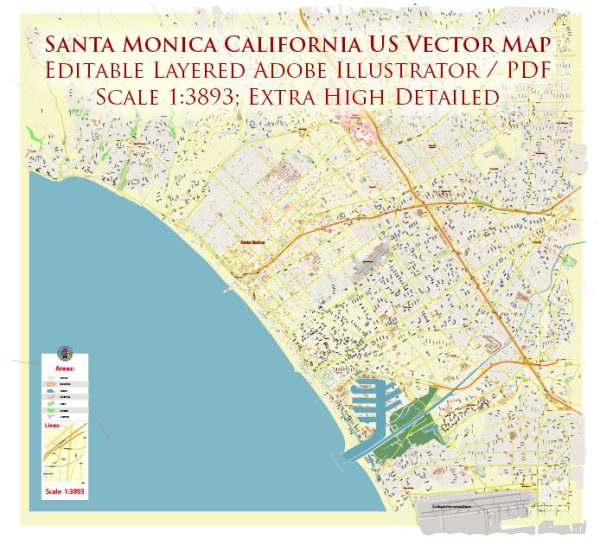Santa Monica, California is known for its diverse and dynamic architecture, which reflects a combination of historical influences, modern design, and the city’s unique coastal setting. Here is a brief description of the architectural characteristics and styles you can find in Santa Monica:
- Beachfront Beauty: Santa Monica’s most iconic architectural feature is its proximity to the Pacific Ocean. Many buildings along the coastline are designed to maximize views of the ocean. You’ll find plenty of modern beachfront homes and apartment complexes with large windows and open balconies.
- Spanish Colonial Revival: This architectural style is prevalent throughout Santa Monica. It draws inspiration from Spanish and Mexican architecture, with features like stucco walls, red-tiled roofs, arched doorways, and wrought-iron accents. Notable examples include the Santa Monica City Hall and the Fairmont Miramar Hotel.
- Art Deco: Santa Monica boasts several Art Deco buildings, characterized by geometric shapes, sleek lines, and decorative motifs. The Georgian Hotel, located along Ocean Avenue, is a prime example of this style.
- Mid-Century Modern: Santa Monica features some excellent mid-century modern architecture, emphasizing clean lines, large windows, and a seamless connection to the outdoors. The Eames House, designed by Charles and Ray Eames, is a famous example.
- Contemporary and Modern: In addition to preserving historical architecture, Santa Monica is home to many contemporary and modern architectural gems. These structures often prioritize sustainable and environmentally friendly design elements. You’ll find innovative residential designs and commercial buildings that incorporate the latest trends in architecture.
- Civic and Institutional Buildings: The city’s civic and institutional buildings vary in style, with some incorporating modern design elements and others adhering to more traditional forms. The Santa Monica Pier, for example, features a mix of architectural styles, including Art Deco and Streamline Moderne.
- Bungalow-Style Homes: In the residential neighborhoods of Santa Monica, you’ll find charming bungalow-style homes that harken back to the early 20th century. These homes often feature low-pitched roofs, porches, and cozy, compact designs.
- Sustainable Design: Santa Monica places a strong emphasis on sustainability and green building practices. You’ll see many buildings that incorporate energy-efficient systems, solar panels, and environmentally friendly materials.
- Adaptive Reuse: The city has a growing trend of adaptive reuse projects, where historic buildings are renovated and repurposed for modern use. This preserves the historical character of the community while allowing for economic growth.
- Mixed-Use Developments: As in many urban areas, Santa Monica has seen the rise of mixed-use developments that combine retail, office spaces, and residential units in the same building. These structures often have a contemporary design with an emphasis on walkability and transit access.
Overall, Santa Monica’s architectural landscape is a rich tapestry of styles, from the historic and iconic to the cutting-edge and sustainable. The city’s architecture reflects its commitment to both preserving its past and embracing the future.


 Author: Kirill Shrayber, Ph.D.
Author: Kirill Shrayber, Ph.D.